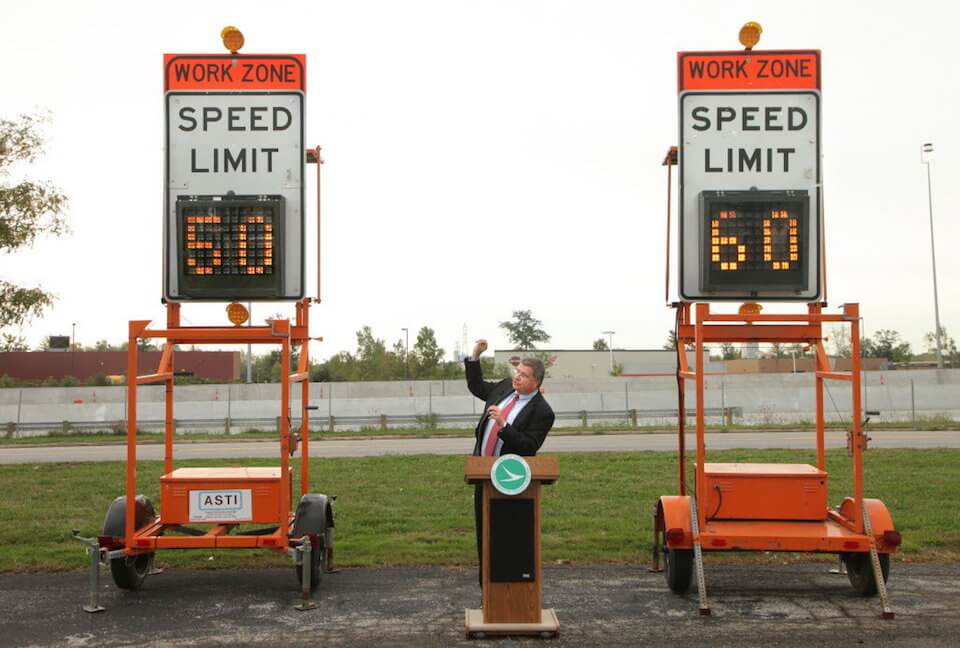Looking Both Ways

Constructive Thoughts for Construction Zones

This post of Looking Both Ways will take a look at driving into, through and out of construction zones. Think more about the way you operate your vehicle and protecting yourself when encountering an orange can orchard. Here are some things to consider:
Speed
Pay attention to signage and decrease speed before entering the defined construction zone.
Operate your vehicle at or below posted construction zone speed limits.
Safely operating your vehicle may require you to drive below the posted speed limits for the construction zone.
Traffic often stops at beginning of construction zones.
Other vehicles may slow, stop, or change lanes unexpectedly.
Increase following distance in construction zones.
Many drivers quickly increase vehicle speed upon exiting construction zones. Unsafe conditions can also exist immediately after a construction zone.
Stopping Distances Refresher
A car takes about 124 feet to 139 feet to come to a stop when traveling at 40 miles per hour from the time that the driver perceives the danger. In comparison, a truck driver takes approximately 169 feet from the danger perception time when traveling at the same speed.


Lane Usage
Many times lanes merge at construction zones.
Merge well before you reach the lane closure.
Change lanes only where pavement markings indicate and only when traffic conditions permit.
Lanes often narrow in construction zones.
Be aware that traffic patterns change frequently in construction zones – don't be over confident of what to expect.
Remember that construction workers, construction work vehicles, or construction equipment may enter your lane without warning – after all, it is a construction zone.

Surroundings and Conditions
Be aware of vehicles behind approaching too fast for conditions.
Be aware of vehicles attempting to cut in front of you.
Be aware of all traffic around you. Look ahead. Be prepared to react to the unexpected.
Be aware of construction vehicles enetering or exiting the highway.
Construction zones have a tendency to accumulate road debris.
Sudden water build up can occur in construction zones.
Vehicles with breakdowns can clog construction zones.
Broken down vehicles may not be able to fully exit lane in construction zone.
Law Enforcement Officers may be present in areas before, in and immediately after leaving construction zones.
Construction Zone Signage

Road work is just ahead. Be prepared for unusual driving conditions and begin to reduce speed.

Traffic is traveling in both directions on a roadway that is normally one way. Be alert for oncoming traffic.

Traffic needs to follow this vehicle to get safely through the work zone.

A lane is about to end, requiring you to merge into the adjacent lane. The "bent" lane shows which lane is ending. There should be no racing to the merge point.

A flagger is ahead. Be prepared to stop and/or follow instructions.

You have reached the end of the work zone. Resume normal, safe driving.

Detours and Special Routing
Construction zones may have detours.
Pay attention to detours having specific truck routing.
Listen to traffic information for area on radio (but do allow radio to distract you).
You will need to take an alternate route soon.
Additional Safe Driving Suggestions for Construction Zones
Use headlights in construction zones.
Fines are often increased for citations received in construction zones. Pay attention to speed and lane usage.
Injuring or killing a construction worker can easily lead to punitive damages due to negligence. Remember that punitive damages are not covered by insurance. Punitive damage awards can cause you to lose everything you have ever worked for. More important – you live with the guilt the remainder of your life.
Avoid distractions entering and driving through construction zones. (Eating, radio, smoking, etc...)
Don't become a Construction Zone Statistic
According to Federal Motor Carrier Safety Administration during the past 5 years in work zone crashes:
- 4,400 persons died (85 percent of which was the driver or passenger).
- 200,000 persons were injured.
- Drivers are the most frequent fatality in work zone crashes.
- Most work zone fatalities involve working-age adults.
- Rear-end crashes (running into the rear of a slowing or stopping vehicle) are the most common type of work zone crash.
- Fatal work zone crashes occur most often in summer and fall.
- The majority of fatal work zone crashes occurred on roads with speed limits greater than 50 mph.
Interesting Orange Barrel Facts
Some barrels are grown right here in Toledo, Ohio.

Pictured above: orchard workers check barrels for ripeness. Only those barrels that are naturally ripened to perfection leave the orchard for road use.
New design orange barrels are costing states more to purchase. The only difference between an old-style barrel and the new is a fluorescent reflective sheeting on the orange and white stripes that is easier to see in low light — at dusk or in rainy weather. The new barrels come with a sharply higher cost. The state of Michigan owns about 10,000 of the plastic barrels, and tens of thousands more are supplied each year by contractors for specific jobs. The barrels, which now cost $51 to $85 each, would increase to $73 to $112 for the new design. Ah, if only we could just grow those barrels.
Disclaimer: This blog is NOT intended to give legal advice, nor be a substitute for any training required by the Regulations.
Till the next blog, Thank you drivers for all you do! Please be safe!
John Mueller, CDS, COSS
[email protected]
www.PTLLLC.com
